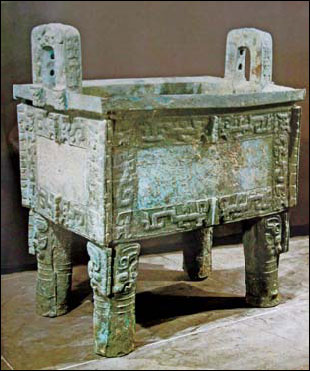- 中文
- EN
- Français
- 日本語
- 한국어
- 繁體中文
Everything You Wanted to Know about Dings

The Si Mu Wu Giant Rectangular Ding Vessel, now in the collection of the National Museum of China.
Every week we look at a work of art or a cultural relic that puts the spotlight on China's heritage.
Bronzeware is a significant symbol of Chinese civilization and the ding vessel "is arguably the most important genre of bronzework created by ancient Chinese, and a key factor in the evolution of Chinese civilization", says National Museum of China researcher Li Xiandeng.
A kind of cauldron with a lid, and loop handles, the ding vessel usually functions as a ritual implement to burn offerings before divination rituals.
It was also a symbol of status and power. Only the elite were allowed to possess ding vessels and the size and number of these vessels were strictly proscribed: The emperor could have nine, dukes and barons seven, high officials five, and scholars three.
The number of dings found in ancient tombs often provides clues as to the status of the interred.
Most ding vessels have three legs, but occasionally have four.
A good example of this kind of heavy bronzeware is the Si Mu Wu Giant Rectangular Ding Vessel.
This iconic ding vessel has vertical "ears" (loop handles) and a rectangular body. Its four legs are hollow. It is 133 cm high, with a 110 cm opening, and four legs that are 46 cm each. Its walls on four sides are 4 cm thick.
Weighing 832.84 kg, it is the largest and heaviest of all bronze vessels unearthed to date.
The vessel was spotted by farmers in a small village near Anyang, in Henan province, March 1939, during the War of Resistance against Japanese Aggression (1937-45).
The four-legged ding was so big and heavy that it could not be moved after being unearthed - even though the invading Japanese army tried on several occasions to take it away.
To protect the cultural relic, locals reburied it, and dug it up again after the war ended in late 1945.
It was later transported to Nanjing, capital of Jiangsu province, by the Kuomintang army. It was first shown to the public on May 29, 1948, causing a sensation.
It is now in the collection of the National Museum of China in Beijing and will be on display in the large-scale, permanent exhibition, Ancient China, scheduled to open in April.
Ding vessels were used in primitive societies as cooking utensils. Initially they were made of clay, but as metallurgy emerged and developed, bronze was used instead, at the end of the Shang Dynasty (16th century-11th century BC).
The Si Mu Wu Giant Rectangle Ding Vessel was made with a high level of casting technique and artistry, representing the highest casting achievement of the Shang Dynasty, Li says.
Research indicates the casting of this huge bronze vessel required more than 1,000 kg of metal and 70 to 80 craftsmen.
The sides of this stately cauldron are carved with vivid relief patterns and images of ferocious animals, around an unadorned rectangular patch.
On the outer surface of either handle are two tigers confronting each other with their mouths wide open while the sides by the "ears" have fish images. There is a human head in the mouth of each animal.
Pictures in relief of kui (a one-legged mythic animal) are carved on four sides of the ding. All the animal figures have an exaggerated style.
The ding vessel got its name because of the three characters - si mu wu - inscribed on its interior wall.



